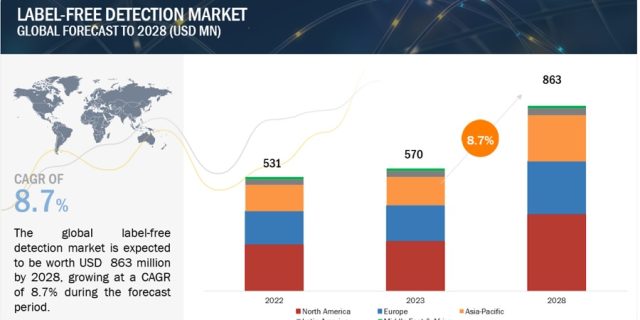
What is Label-free Detection?
Label-free detection is increasingly recognized as a crucial tool in research and development within academic institutes and the biotechnology and pharmaceutical industries. This technology enables the study of molecule-molecule interactions without the need for additional isotope or fluorescent labels, which can interfere with spatial resolution or cause quenching.
Label-free Detection Market Projection
The Label-free Detection Market is expected to grow from USD 570 million in 2023 to USD 863 million by 2028, at a CAGR of 8.7% during the forecast period.
This growth is fueled by the rising prevalence of target diseases and disorders, the availability of funding for life science research, and the effectiveness of label-free technology in drug discovery. Technological advancements are also expanding the applications and adoption of label-free detection products.
Key Market Dynamics
Drivers
- Technological Advancements: Continuous innovations in label-free detection technologies.
- Academic-Industrial Partnerships: Increased collaborations for drug discovery programs.
- High Sensitivity: Label-free technologies offer highly sensitive detection capabilities.
Restraints
- High Costs: The expensive nature of label-free detection instruments.
Opportunities
- Emerging Markets: Growing life sciences research in developing economies.
Challenges
- Sample Complexity: Issues related to sample complexity and interference.
Trends
- Pharmaceutical Outsourcing: Increasing outsourcing in the pharmaceutical industry.
- Electrochemical Sensing Platforms: Expanding applications of label-free electrochemical sensing.
Market Segmentation
By Type
- Instruments: Largest segment in 2022.
- Consumables
- Software & Services
By Technology
- Surface Plasmon Resonance: Dominated the market in 2022.
- Differential Scanning Calorimetry
- Bio-layer Interferometry
- Isothermal Titration Calorimetry
- Other Label-free Detection Technologies
Regional Analysis
North America Market Growth
The label-free detection market in North America has seen significant growth due to well-established research infrastructure, a strong pharmaceutical and biotech industry, increasing government support for life science research, technological advancements, and collaborative initiatives. These factors contribute to the robust expansion of the label-free detection market in the region.
Recent Developments
- April 2022: Sartorius launched the Octet SF3, the first SPR system under the Sartorius Octet brand, offering high-throughput and low-maintenance biomolecular interaction characterization.
- February 2021: Creoptix, a subsidiary of Malvern Panalytical, introduced WaveRAPID, a new method for measuring kinetics to accelerate drug discovery.
Top Key Players
Leading companies in the label-free detection market include:
- Danaher (US)
- Sartorius AG (Germany)
- Waters Corporation (US)
- PerkinElmer, Inc. (US)
- AMETEK, Inc. (US)
- HORIBA, Ltd. (Japan)
- Spectris (UK)
- METTLER TOLEDO International Inc. (US)
- Agilent Technologies, Inc. (US)
- Shimadzu Corporation (Japan)
- Hitachi High-Tech Corporation (Japan)
- Attana AB (Sweden)
- Bruker (US)
- NanoTemper Technologies GmbH (Germany)
- Affinité Instruments (Canada)
- Biosensing Instrument (US)
- Unchained Labs (US)
- BioNavis Ltd. (Finland)
- Carterra, Inc. (US)
- Nicoya (Canada)
- BiOptix Analytical LLC (US)
- Plexera Bioscience (US)
- XanTec Bioanalytics GmbH (Germany)
- lino Biotech AG (Switzerland)
- KEP Technologies (France)
These companies are significantly impacting the market through technological advancements, increased drug discovery efforts, growing investment in life sciences research, and the need for more accurate and direct biomolecular interaction measurements.
Conclusion
The Label-free Detection Market is poised for robust growth, driven by technological advancements, increased research funding, and the rising prevalence of target diseases. While high instrument costs and sample complexity pose challenges, emerging markets and expanding applications present significant opportunities. Leading companies continue to innovate and form strategic partnerships to capitalize on this dynamic market.

